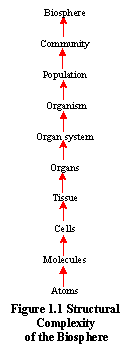| PinkMonkey Online Study Guide-Biology
1.1 Practical Biology

Introduction
Living things are made up of cells which form
the basic unit of life. The cell is, in turn, made up of molecules
and atoms. The cell usually cannot be seen with the naked
eye. Each cell performs certain functions. Some functioning cells
come together organize to form a tissue. It is at this stage that
the complex structuring of living things begins. A group of tissues,
when organized, form organs such as the brain, the heart, etc. When
a number of organs work together, they compose an organ
system. So an organism is a composite union of various
organ systems. The combination of several organisms is called population,
which, in turn, forms a community, leading to the creation
of a Biosphere. Figure 1.1 represents the structural complexity
of the Biosphere.
i) Metabolism
An organism is basically made up of six
basic elements: C, H, O, N, P and Ca. These make up about 96% of
the weight of an organism. To keep life intact there is an exchange
of chemical matter from cell to environment and environment to cell.
Organic matter from the environment is absorbed by the cell and
utilized for preparing energy. The energy thus prepared is used
to perform the functions of the cell. Unlike in nonliving things,
a number of physical and chemical changes take place in the body
of the organism. The sum total of physical and chemical changes
in an organism is called metabolism. Metabolism includes anabolism
in which complex organic substances are built up and energy is stored,
and catabolism in which the complex organic substances are broken
down to release energy. These changes of conservation and release
of energy continuously take place in the organism. This energy is
basically in the form of chemical energy. Nonliving matter does
not show this kind of exchange of energy.
ii) Growth
In metabolism we have seen that organic
matter is collected from the environment and processed in the cell.
In the process of growth, the cell organizes this material into
its own structure. During growth the cell spends some amount of
the energy created in the process of metabolism. Every organ has
its own pattern of growth. This pattern depends upon the tissue
of the organ. Growth of different organs leads to physical growth.
Food is converted into organic matter which is then utilized for
the growth of the body. Nonliving organisms do not show these characteristics.
iii) Reproduction
A living thing has the ability to procreate
when it matures through the process of reproduction. There are differences
in the reproductive functions of higher animals and lower animals.
In lower animals (as in unicellular animals like amebas and bacteria),
reproduction merely extends the process of growth. For instance,
after maturity, a single bacterium splits into two bacteria, in
six stages. This process is called asexual reproduction. In asexual
reproduction only one parent is involved. So generally the produced
cells are identical to the parent cell. In asexual reproduction,
the rate of production of offspring is faster than in sexual reproduction.
In higher or more complex organisms there is another type of reproduction
called sexual reproduction. In sexual reproduction, two parents
of opposite gender type are responsible for the formation of a new
organism. During sexual reproduction, a new combination of genetic
material (D.N.A.) occurs. This process is complex and takes more
time than asexual reproduction. Nonliving things do not reproduce.
|
Table of Contents
1.0 - Introduction
1.1 Practical Biology
1.2 Scientific Methodology
Chapter 2
|